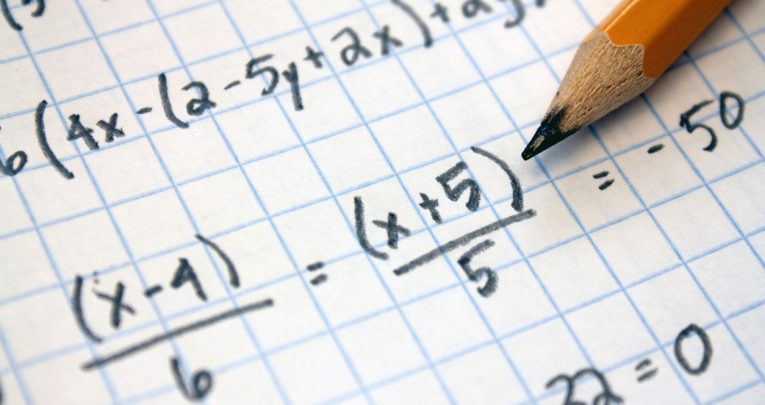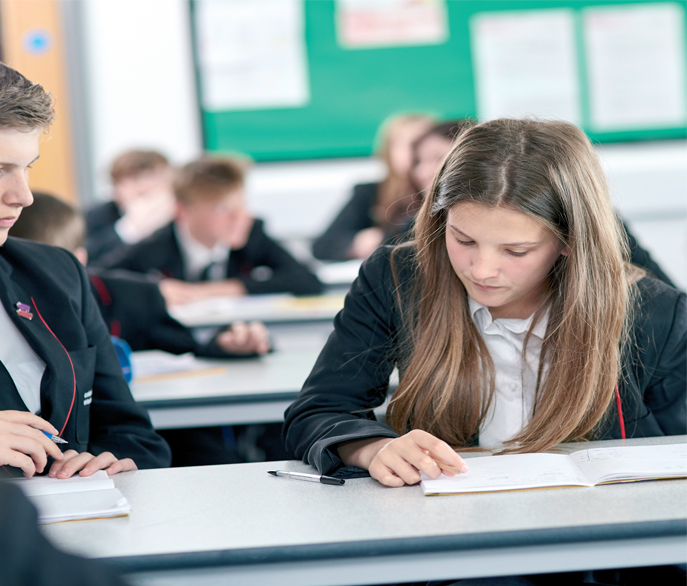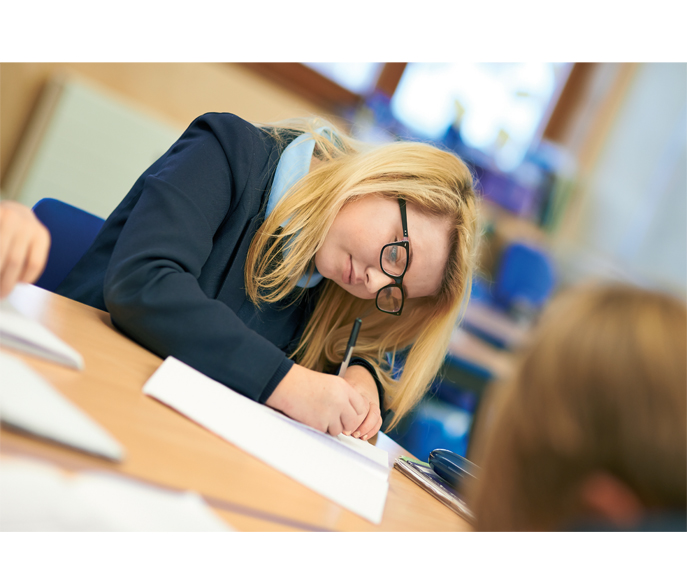


by Colin Foster Share
Save Like --> Share

In this lesson, students work on a task about pink paint, which is made from a mixture of red paint and white paint.
How much red paint do you need to add to pink paint which is 60% red to turn it into pink paint which is 80% red?
People frequently vastly overestimate or underestimate many everyday risks, which can lead to poor decision making.
One way to estimate the probability of something happening is to carry out an experiment and obtain some data on how many times it occurs out of a certain number of trials. The proportion of occurrences (relative frequency) gives an estimate of the probability, and this estimate generally improves the more trials that you do.
In this lesson plan by Colin Foster, students will carry out an experiment to estimate the probability that when three ordinary dice are thrown, they will show consecutive numbers. Students will explore how their estimates change as more and more throws are included, leading to an appreciation of the law of large numbers.
Percentages are commonplace in everyday life, but can be sometimes be confusing and difficult to interpret. In this lesson plan by Colin Foster, students get to grips with a series of puzzles aimed at showing what changes in percentage actually mean…
If you choose which student will answer a question by drawing lolly sticks bearing their names from a cup, how many questions would need to be asked before everyone has a chance to answer? That’s the subject of this KS3 maths lesson that sets up a problem solving activity on probability.
Working out how many large and small bags of doughnuts to buy so as to get your treats as cheaply as possible involves students in some careful mathematical reasoning.

Lots of learners have heard that ‘two minuses make a plus’ but may not apply this rule correctly or have much sense of when or why it is the case. In this lesson, links are made to the science topic of electricity to help learners understand adding and subtracting directed (positive and negative) numbers.

Help students practise their maths skills with these free maths homework question packs for Year 7, Year 8, Year 9 and GCSE maths.
‘Simplifying Expressions’ lesson plan and accompanying task sheet (originally published in volume 5, issue 2 of Teach Secondary magazine).
Exercises are not the only way to improve students’ fluency in mathematical procedures – sometimes the very same skills can be developed in a more exploratory fashion.
Expanding brackets and collecting like terms to simplify expressions are perhaps not the most exciting of mathematical topics, but fluency in these skills is needed in order to solve equations and engage with more stimulating mathematical problem solving. Unless students take the time to master these skills, they will be disadvantaged later – but how can we avoid lessons on algebraic manipulation descending into endless mindless drill and practice?
One way is to engage students in devising expressions that will simplify to produce a given result – in this lesson, the expression ‘5x + 8y’. Restricting the possible expressions that can be combined to make this to five given linear binomials forces students to engage in some careful trial and improvement.
To find all the possible solutions, they will have to engage with negative coefficients, leading to plenty of opportunities for strengthening their skills in expanding and simplifying algebraic expressions.
Click here to get this free lesson plan. Browse algebra games to play online and offline.
Prime numbers are all around us, and they’re important, yet some are more important than others. Help your pupils discover how and why that is, using this lesson plan from Colin Foster.
Students can often learn to perform a procedure successfully without much understanding of what they are doing – let alone why they are doing it! A good way to help them get a deeper understanding is to present them with an inverse task, where they have to try to do the opposite process.
This is usually harder and, unless they have learned it as a standard procedure, requires some careful thinking to unpick what they know. In the topic of enlargements of 2D shapes, students are normally asked to enlarge a given shape with a given scale factor about a given centre of enlargement, or to describe in these terms an enlargement that has already been drawn.
Sometimes they are asked to find the centre of enlargement or scale factor for a given enlargement.
In this lesson, students are asked to decide where the centre of enlargement can go for a given shape with a scale factor of 3 enlargement so that no part of the image will go off the edge of the grid. Solving this problem involves students in intelligent trial and error as they experiment with various possible centres of enlargement in order to locate the locus of possible positions.
A million pounds sounds like a lot of cash, but exactly how much is it really? Converting a vague notion of ‘wealth’ or ‘riches’ into actual pound coins can be an extremely useful and engaging way of encouraging learners to carry out estimations involving large numbers, mass and volume.
Learning mathematics is about making sense of mathematical situations. These puzzles provide an interesting context in which students can make predictions and conjectures and develop their powers of mathematical reasoning.
In this lesson students will investigate the relationship between numbers in a diagram and justify their reasoning.

Multiplication is a fundamental operation in mathematics which every student needs to understand and be comfortable with. Although nowadays we have computers and calculators to do routine calculations for us, we still need to understand what multiplication does and when to use it.
It is also important to have a sense for what size an answer should be, so that we can make useful estimates when accuracy is not essential and spot errors when using technology.
In this lesson, students have to try to make the maximum product possible by making two numbers from the digits 1 to 9 and multiplying them together. This task allows students to generate lots of practice through trial and error but also focuses their thinking on place value and the optimal positions for the highest-value digits.
Instead of treating algebra as a foreboding, abstract topic to be feared, says Colin Foster students ought to see it as a useful tool that can actually make their learning of maths a whole lot easier.
‘A Day at the C-Side’ gets Pythagoras’ theorem questions stuck in learners’ minds by allowing them to discover the theorem themselves.
In this lesson, pupils draw tilted squares and find their areas, then use these values to draw conclusions about the lengths of oblique lines on a square grid – leading to a statement and proof of Pythagoras’ theorem.
In this lesson, assistant maths professor Dr Colin Foster shows how you can start with an answer – ‘5x + 8y’ in this instance – and work back from there, getting your students to find as many solutions as they can, while picking up key knowledge of negative coefficients along the way.
‘Change the Subject’ develops pupils’ algebra skills so that they can rearrange equations confidently, which is an important skill both in mathematics and other subjects like science and design and technology.
Remind your students that maths isn’t just about numbers with this detailed lesson from Colin Foster that encourages pupils to take a closer look at what we know about geometry, and polygons in particular.
What makes a parallelogram a parallelogram? Can the attributes of a shape be mathematically defined and used to decide whether, say, something that looks like a rhombus actually is one?

Can you make a shape sorter, with at least four different shapes and holes, so that each shape will go through just one of the holes?
This lesson plan looks at shape sorter toys – which will be familiar to most students, particularly if they have a younger sibling – as designing and making one can be a good challenge for those in Key Stage 3. It requires a lot of careful thought, particularly if we want to avoid any shapes fitting through the ‘wrong’ hole.
Students will have to decide which shapes to include (they can go for easy or hard options), how big to make them, and how to draw out the required nets accurately. An additional constraint can be that all of the shapes should be able to fit inside the finished box at the same time.
The angles created by overlapping regular polygons can be easy or difficult to calculate, depending on what information you are given. So, taking a creative approach to important mathematical processes like this can deepen students’ understanding of the principles involved and develop vital skills of reasoning and deduction.
In this open ended lesson, learners explore a sequence of gradually larger shapes and consider what mathematical questions they can ask about them. What is the same and what is different about a group of triangles, and how can they be drawn accurately. What measurements make an impossible triangle, and can students work out which triangles come next in a sequence? This KS4 lesson also gives students the chance to use Cosine.
Although we live in a digital age, analogue timepieces are still all around us and provide a helpful context for exploring angles.
Students often approach the topic of angles by memorising lots of vocabulary (acute, obtuse, right angle, etc) and ‘facts’ about angles around a point, on a straight line, inside and outside a triangle and other polygons and between a transversal and parallel lines.
Then they have to choose the appropriate rule to get the right answer to each calculation.
In this lesson, a clock face is used to stimulate some calculations involving angles. First, students are invited to estimate the size of the angle and then to calculate it exactly. Initially, some of the calculations are quite easy, while others are more complicated as the lesson progresses. Provided that students know that there are 360° in a whole turn, they should be able to work out everything else for themselves.
‘Shape Up’ teaches students about line and rotational symmetry and how they are related, getting them to invent and draw their own shapes with particular symmetries.
Ladders leaning against walls is a classic scenario for mathematics problems and is often used to address topics such as Pythagoras’ theorem and trigonometry.
In this lesson, the situation of two crossing ladders is used as an opportunity to work on ideas relating to similar triangles.
How high will the crossing point be above the ground and how far will it be from each wall? What happens for different lengths of ladders? What happens if the walls are further apart or closer together?
Students need to identify triangles that are similar and then construct equal ratios to work out their answers. They will notice interesting properties, such as the fact that the distance between the walls does not affect the height of the crossing point. There are also connections with an average called the harmonic mean.
Learners are often asked to practise finding the third angle of a triangle when the other two are given. In this lesson they get the opportunity to work on the topic area by finding all three angles according to different constraints.
Browse more KS3 maths games and lesson ideas.

Applying their knowledge of scale and Pythagoras’ Theorem, students are tasked with calculating the shortest route between two destinations on a map and explaining their reasoning as clearly as possible in this detailed lesson plan devised by Colin Foster.
‘Hopping Along’ sees students examine the effect that margins of error can have on otherwise seemingly clear results. Starting with the seemingly clear result of a race, students look at how multiple inaccuracies in the measurement of distance and time can combine to produce a very different – and even counter-intuitive – outcome.
In this lesson, students use Pythagoras’ theorem to find accurate values for the perimeters of some triangles. Although the values of the perimeters are so close that it would be very hard to distinguish them by measurement, mathematics makes it possible to be absolutely sure about the order in which they come.
Traditionally, pupils are taught geometrical transformations by learning a set of skills they can apply to reflecting, rotating and enlarging shapes without giving the process too much thought. But what if they were to called upon to use those skills to solve a mathematical problem?
In this lesson by Colin Foster, that’s precisely what they’re tasked with doing…
In geometry students need to use their spatial reasoning and visualisation skills to understand the shapes and how they will move when broken down into points and lines. This lesson allows pupils to look at two fixed points and how they relate to other points.
‘The What Factor?’ takes the ideas of highest common factor and lowest common multiple, which are often taught separately, and deals with them together to help learners to appreciate the connections between them.

In this lesson, algebra is used to make sense of a number trick that the teacher performs.
Students are asked to explore the mechanics, experiment with some numbers, and then use algebra to try to probe exactly how and why the trick works.
It’s easy to check the rule on a few numerical examples by working them out, but a short piece of algebra helps students to see what is going on under the surface.
This lesson provides an opportunity to work on expanding brackets and simplifying algebraic expressions, as well as making sense of the final answer in terms of the place value of the original numbers.
This lesson is about calculating how long it will take to paint a wall if several people work at it at the same time. Will it take less time with more people helping? And if so then how much less?
Students need to make assumptions that are realistic to the real-world situation, but they also have to make assumptions that will make the calculations easy to do and give an answer that is close enough for practical purposes. Pupils often find calculations involving rates difficult. They may be tempted to add up the times rather than the rates, and this provides an opportunity for discussion and for deciding whether or not different possible answers obtained are reasonable.
This download contains one lesson plan guide and one accompanying task sheet.
In many everyday scenarios, we cannot calculate a theoretical probability of something happening.
Even some simple-sounding games involving dice are complicated to analyse and the easiest way to estimate the probability of a win is often to run a simulation on a computer.
In this lesson, students are asked to estimate the probability of winning a game in which they throw an ordinary dice and move a counter that many spaces forwards.
To win, they must ‘hit ten’ by landing on the tenth square from the start. This game is too complicated for students to work out the probability of winning theoretically, so they must estimate it by playing the game several times and seeing how often they win. This enables them to calculate how much money they might be willing to pay to play the game, if the prize for winning is £1.
They’ve been taught the technique a dozen times or more…but through embedding it within a richer problem, ‘adding and subtracting fractions’ might finally make sense to students.
Mathematical questions about a photo in a carpark gives a real-life context to this maths lesson. Students will devise their own investigations about the photo that will involve money, algebra, and finding patterns. Logical thinking and careful arithmetic are also required in this KS4 lesson.
Quadratic expressions are considerably more complicated to work with than linear expressions, and students often find them hard to handle.
Students may carry out factorising of quadratics by applying poorly-understood procedures that make little mathematical sense to them, and this can be especially so when it comes to non-monic quadratics (those where the coefficient of x2 is not 1).
In this lesson, students approach factorising non-monic quadratics by trying to find factorisations which will expand and simplify to produce a quadratic expression of a specified form.
This entails lots of useful practice at expanding pairs of brackets and collecting like terms, and also gives opportunity for students to unpick what is going on, so as to gain insight into how the inverse process of factorising works.
By working backwards in this way to obtain the necessary factors, students build a deeper understanding of factorising quadratics.

Understanding when one integer will divide exactly into another helps students to ‘make friends’ with the integers and feel more secure when carrying out calculations.
Even when students are using calculators, this sort of familiarity with factors enables students to estimate the sizes of answers (and such things as whether an integer should be obtained or not).
All of this provides valuable checks on the work that they are doing and can be more intellectually stimulating than merely following standard algorithms to get an answer.
In this lesson, students have the opportunity to experiment with producing ‘nice’ answers like 123 456 from multiplying integers.
‘Connected Quadratics’ helps students become confident and fluent with techniques such as factorising quadratics by offering a scenario in which they need to construct their own quadratic equations in order to solve a bigger problem…
‘What’s the Point?’ teaches shading graphical inequalities, but not as a sequence of instructions to follow, as it is often done. Instead, asking learners to find a ‘mystery point’ can bring the process to life…
If your maths students are struggling to see the point of why we have histograms, this lesson devised by Colin Foster will quickly highlight the limitations of the bar charts they learnt about in primary school.
Students here are tasked with devising bar charts in a deliberately misleading way, by splitting data concerning visitor numbers at a sports centre into different categories. However, when they use the same data to plot histograms, it will soon become clear that their ability to show frequency density helps to communicate an accurate sense of what the data distribution really is.
Flowcharts are a highly visual way of communicating information and are used in this lesson to set up rules about operations that will be performed iteratively. Students are invited to explore what happens when they put different numbers into a given flowchart, and later to experiment with varying the features of the flowchart themselves. They will encounter some converging sequences and use algebra to predict and explain the outcomes.
Developing fluency with a particular mathematical technique to the point where students no longer need to think about the details can give them a powerful sense of mastery. This enables them to tackle more demanding mathematical problems that rely on that process and contributes to a wider confidence in the subject.
Adding and subtracting fractions is a procedure which students often find it very difficult to master, despite sometimes having been taught it every year from upper primary school to the sixth form. They’ll do it for a few lessons but then quickly forget it again for another year – particularly in this age of calculators and computers.
When revisiting this topic at Key Stage 4, therefore, it can bring up powerful memories of failure, so it is important to address the area without it feeling like an exact repetition of what they have done before.
One way to make the practice of a technique less tedious than a page of exercises is to embed it in a bigger problem which students are trying to solve. Having their attention on a grander purpose helps them to internalise the method to the point where they don’t have to think about it any more, which is always the goal of mathematical fluency.
A problem-based approach also means that the answers obtained have some significance for the wider problem, so students are more inclined to check their answers and notice if any of them doesn’t seem to be about the right size.
The language of averages is used all the time in the world around us – and budding mathematicians need to understand exactly what such terms represent.
Many students will know how to calculate the mean: they add up all the numbers and divide by how many there are. However, it is common to find that students are less sure about exactly what the value that they have calculated actually means.
This lesson helps to make sense of the meaning of the mean as well as exploring efficient ways to calculate it.

Working out how to carry enough food to stay alive in a challenging environment poses interesting problems.
In this lesson, students use their knowledge of ratio to make sense of a real-world scenario in which enough food must be carried into the desert to allow a group of people to survive for a certain length of time.
SHARE THIS resourceYou'll also receive regular updates from Teachwire with free lesson plans, great new teaching ideas, offers and more. (You can unsubscribe at any time.)
Thank you for signing up to our emails!